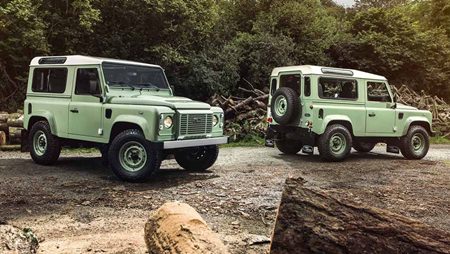Production of the Land Rover Defender will end in October after almost 70 years of continuous construction, with more than 2 million vehicles produced over the years.
To commemorate the final run, Land Rover has produced limited edition Heritage versions of the Defender 90 and 110, as well as a harder edged Adventure version of both vehicles.
Less than 5000 will be built for markets across the world. The Defender is Land Rover’s military style vehicle, built tough to take drivers into some of the harshest environments in the world.
 Goodbye Landy.
Goodbye Landy.
It was developed from the original Land Rover that went into production in 1948 and while it has continued to evolve over the years, it is a vehicle that remains true to the original concept.
Unfortunately, it can simply no longer meet the mandatory safety requirements imposed on modern vehicles.
The last Defender is available in two and four-door versions of the car, the short wheelbase Defender 90 and long wheelbase Defender 110, with many variations over the years including a dual cab pick-up. The numbers refer to the wheelbase in inches.
Land Rover has had a checkered past, having been owned by several different groups including British Aerospace!
1947: Rover’s chief designer Maurice Wilks and his associates create a prototype using Jeep chassis and components.
1948: The first Land Rover was officially launched 30 April 1948, at the Amsterdam Motor Show.
1958: Series II launched.
1961: Series IIA began production.
1967: Rover becomes part of Leyland Motors Ltd, later British Leyland (BL) as Rover Triumph.
1970: Introduction of the Range Rover.
1971: Series III launched.
1974: Land Rover abandons US market, facing competitive pressure from Japanese 4×4 brands.
1975: BL collapses and is nationalized, publication of the Ryder Report recommends that Land Rover be split from Rover and be treated as a separate company within BL and becomes part of the new commercial vehicle division called the Land Rover Leyland Group.
1976: One millionth Land Rover leaves the production line.
1978: Land Rover Limited formed as a separate subsidiary of British Leyland.
1980: Rover car production ends at Solihull with Solihull now exclusively for Land Rover manufacture.
1983: Land Rover 90 (Ninety)/110 (One-Ten)/127 (renamed Defender in 1990) introduced.
1986: BL plc becomes Rover Group plc.
1987: Range Rover is finally introduced to the US market, following many years of demand being filled by grey market sales.
1988: Rover Group is privatized and becomes part of British Aerospace, and is now known simply as Rover.
1989: Introduction of Discovery.
1994: Rover Group is taken over by BMW. Introduction of second-generation Range Rover.
1997: Land Rover introduces the Special Edition Discovery XD with AA Yellow paint, subdued wheels, SD type roof racks, and a few other off-road upgrades directly from the factory. Produced only for the North American market, the Special Vehicles Division created only 250 of these bright yellow SUV’s.
1997: Introduction of Freelander.
1998: Introduction of second generation of Discovery.
2000: BMW breaks up the Rover Group and sells Land Rover to Ford for £1.8 billion.
2002: Introduction of third-generation Range Rover.
2004: Introduction of third-generation Discovery/LR3.
2005: Introduction of Range Rover Sport.
2005: Adoption of Jaguar AJ-V8 engine to replace the BMW M62 V8 in the Range Rover.
2005: Land Rover “founder’ Rover, collapses under the ownership of MG Rover Group.
2006: Announcement of a new 2.4 liter diesel engine, 6 speed gearbox, dash and forward-facing rear seats for Defender. Introduction of second generation of Freelander (Freelander 2). Ford acquires the Rover trademark from BMW, who previously licensed its use to MG Rover Group.
8 May 2007: 4 millionth Land Rover rolls off the production line, a Discovery 3 (LR3), donated to The Born Free Foundation.
12 June 2007: Announcement from the Ford Motor Company that it plans to sell Land Rover and also Jaguar Cars.
August 2007: Tata Motors and Mahindra and Mahindra as well as financial sponsors Cerberus Capital Management, TPG Capital and Apollo Global Management expressed their interest in purchasing Jaguar Cars and Land Rover from the Ford Motor Company.
26 March 2008: Ford agreed to sell their Jaguar Land Rover operations to Tata Motors.
2 June 2008: Tata Motors finalized their purchase of Jaguar and Land Rover from Ford.
2010: Introduction of fourth-generation Discovery/LR4.
2011: The Range Rover Evoque introduced.
2012: Fourth-generation Range Rover was exhibited at the 2012 Paris Motor Show.
2014: The New Discovery Range exhibited at the 2014 New York Motor show.
2015: The end of the original line.




